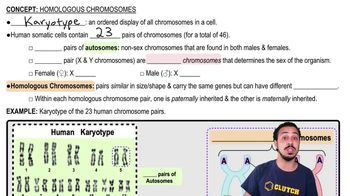Table of contents
- 1. Introduction to Biology2h 42m
- 2. Chemistry3h 40m
- 3. Water1h 26m
- 4. Biomolecules2h 23m
- 5. Cell Components2h 26m
- 6. The Membrane2h 31m
- 7. Energy and Metabolism2h 0m
- 8. Respiration2h 40m
- 9. Photosynthesis2h 49m
- 10. Cell Signaling59m
- 11. Cell Division2h 47m
- 12. Meiosis2h 0m
- 13. Mendelian Genetics4h 44m
- Introduction to Mendel's Experiments7m
- Genotype vs. Phenotype17m
- Punnett Squares13m
- Mendel's Experiments26m
- Mendel's Laws18m
- Monohybrid Crosses19m
- Test Crosses14m
- Dihybrid Crosses20m
- Punnett Square Probability26m
- Incomplete Dominance vs. Codominance20m
- Epistasis7m
- Non-Mendelian Genetics12m
- Pedigrees6m
- Autosomal Inheritance21m
- Sex-Linked Inheritance43m
- X-Inactivation9m
- 14. DNA Synthesis2h 27m
- 15. Gene Expression3h 20m
- 16. Regulation of Expression3h 31m
- Introduction to Regulation of Gene Expression13m
- Prokaryotic Gene Regulation via Operons27m
- The Lac Operon21m
- Glucose's Impact on Lac Operon25m
- The Trp Operon20m
- Review of the Lac Operon & Trp Operon11m
- Introduction to Eukaryotic Gene Regulation9m
- Eukaryotic Chromatin Modifications16m
- Eukaryotic Transcriptional Control22m
- Eukaryotic Post-Transcriptional Regulation28m
- Eukaryotic Post-Translational Regulation13m
- 17. Viruses37m
- 18. Biotechnology2h 58m
- 19. Genomics17m
- 20. Development1h 5m
- 21. Evolution3h 1m
- 22. Evolution of Populations3h 52m
- 23. Speciation1h 37m
- 24. History of Life on Earth2h 6m
- 25. Phylogeny2h 31m
- 26. Prokaryotes4h 59m
- 27. Protists1h 12m
- 28. Plants1h 22m
- 29. Fungi36m
- 30. Overview of Animals34m
- 31. Invertebrates1h 2m
- 32. Vertebrates50m
- 33. Plant Anatomy1h 3m
- 34. Vascular Plant Transport1h 2m
- 35. Soil37m
- 36. Plant Reproduction47m
- 37. Plant Sensation and Response1h 9m
- 38. Animal Form and Function1h 19m
- 39. Digestive System1h 10m
- 40. Circulatory System1h 57m
- 41. Immune System1h 12m
- 42. Osmoregulation and Excretion50m
- 43. Endocrine System1h 4m
- 44. Animal Reproduction1h 2m
- 45. Nervous System1h 55m
- 46. Sensory Systems46m
- 47. Muscle Systems23m
- 48. Ecology3h 11m
- Introduction to Ecology20m
- Biogeography14m
- Earth's Climate Patterns50m
- Introduction to Terrestrial Biomes10m
- Terrestrial Biomes: Near Equator13m
- Terrestrial Biomes: Temperate Regions10m
- Terrestrial Biomes: Northern Regions15m
- Introduction to Aquatic Biomes27m
- Freshwater Aquatic Biomes14m
- Marine Aquatic Biomes13m
- 49. Animal Behavior28m
- 50. Population Ecology3h 41m
- Introduction to Population Ecology28m
- Population Sampling Methods23m
- Life History12m
- Population Demography17m
- Factors Limiting Population Growth14m
- Introduction to Population Growth Models22m
- Linear Population Growth6m
- Exponential Population Growth29m
- Logistic Population Growth32m
- r/K Selection10m
- The Human Population22m
- 51. Community Ecology2h 46m
- Introduction to Community Ecology2m
- Introduction to Community Interactions9m
- Community Interactions: Competition (-/-)38m
- Community Interactions: Exploitation (+/-)23m
- Community Interactions: Mutualism (+/+) & Commensalism (+/0)9m
- Community Structure35m
- Community Dynamics26m
- Geographic Impact on Communities21m
- 52. Ecosystems2h 36m
- 53. Conservation Biology24m
12. Meiosis
Meiosis I
Problem 2`
Textbook Question
The two homologs of a pair move toward opposite poles of the dividing cell during
a. Mitosis
b. Meiosis I
c. Meiosis II
d. Fertilization
 Verified step by step guidance
Verified step by step guidance1
Understand the process of cell division: Mitosis and meiosis are two types of cell division. Mitosis results in two identical daughter cells, while meiosis results in four genetically diverse daughter cells.
Identify the stages of meiosis: Meiosis consists of two stages, meiosis I and meiosis II. Meiosis I is where homologous chromosomes are separated, and meiosis II is where sister chromatids are separated.
Focus on meiosis I: During meiosis I, homologous chromosomes (pairs of chromosomes, one from each parent) are separated and move toward opposite poles of the cell.
Compare with mitosis: In mitosis, sister chromatids are separated, not homologous chromosomes. This is a key difference between mitosis and meiosis I.
Consider the options: Given the options a. mitosis, b. meiosis I, c. meiosis II, and d. fertilization, meiosis I is the correct stage where homologous chromosomes move toward opposite poles.
 Verified video answer for a similar problem:
Verified video answer for a similar problem:This video solution was recommended by our tutors as helpful for the problem above
Video duration:
1mPlay a video:
Was this helpful?
Key Concepts
Here are the essential concepts you must grasp in order to answer the question correctly.
Homologous Chromosomes
Homologous chromosomes are pairs of chromosomes in a diploid organism, one inherited from each parent, that have the same genes at the same loci but may have different alleles. They are crucial in processes like meiosis where they pair up and exchange genetic material, ensuring genetic diversity.
Recommended video:
Guided course

Homologous Chromosomes
Meiosis I
Meiosis I is the first division in meiosis where homologous chromosomes are separated into two different cells. This phase includes prophase I, where crossing over occurs, and anaphase I, where homologs move toward opposite poles, reducing the chromosome number by half and creating genetic variation.
Recommended video:
Guided course

Meiosis I
Chromosome Segregation
Chromosome segregation is the process during cell division where chromosomes are distributed into daughter cells. In meiosis I, homologous chromosomes are segregated, ensuring each gamete receives one chromosome from each pair, which is essential for maintaining genetic stability across generations.
Recommended video:
Guided course

Homologous Chromosomes







